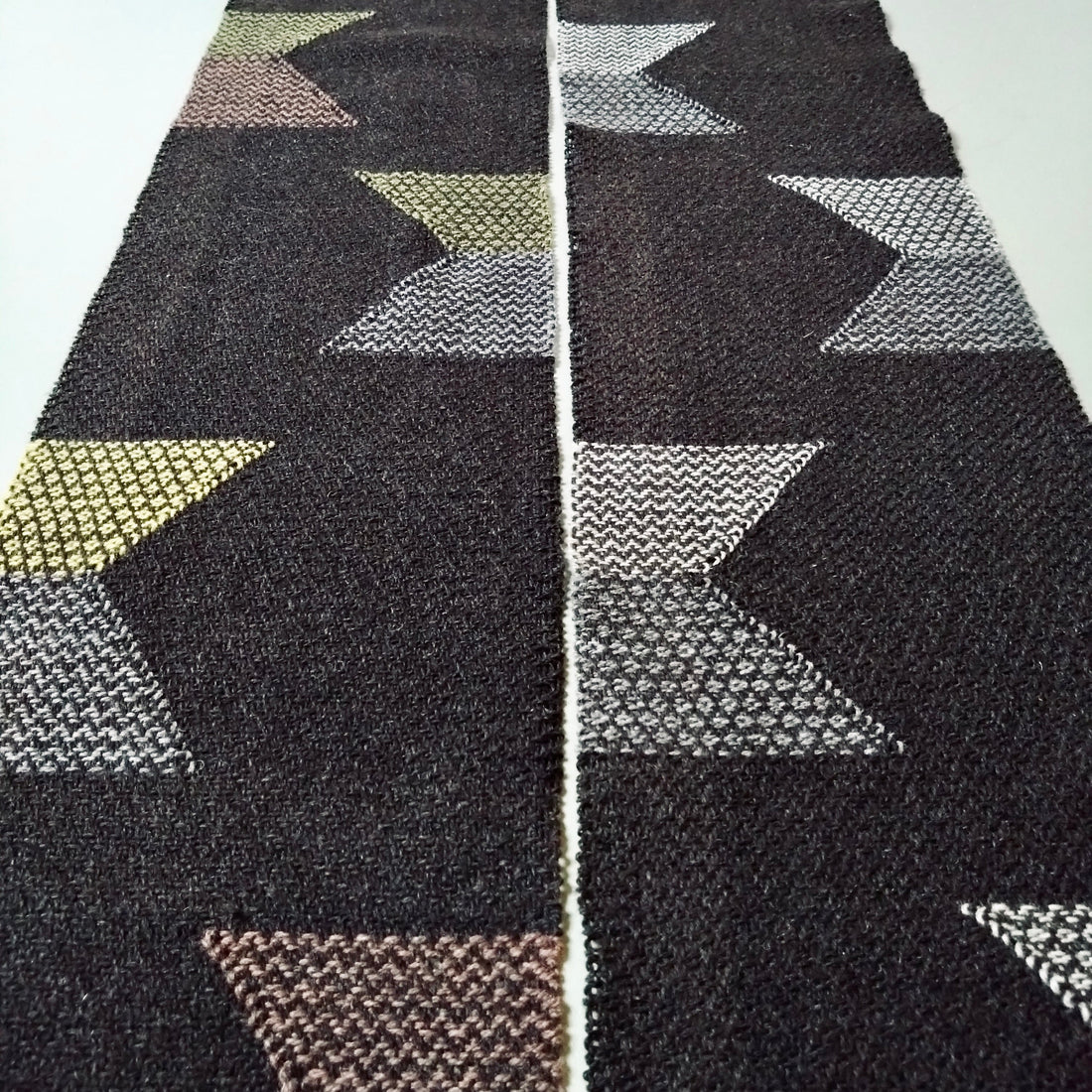
5 Minutes with a Friend: Jade Ogden of The Handloom Room
On the high ridges of the windswept Mendip Hills, Jade Ogden is at her loom. Her studio, The Handloom Room, is a place where wool from nearby flocks becomes cloth, and the slow, steady rhythm of weaving echoes the cycles of the land. Scarves, cushions, and woven artworks emerge from her hands, each one carrying the colours of the Somerset landscape: undyed fibres, soft plant tones, and the gentle marks of season and place.
 Wildflower Scarf, handwoven with regeneratively farmed wool. The colours are the natural shades of the sheep, plus a naturally dyed inclusion of rhubarb root.
Wildflower Scarf, handwoven with regeneratively farmed wool. The colours are the natural shades of the sheep, plus a naturally dyed inclusion of rhubarb root.
Jade came to weaving through a winding path: a BA in Creative Arts at Bath Spa, an MA in Community and Participatory Arts at Goldsmiths, and finally the moment in a London studio when she felt the pull of the loom. What has kept her there is not only the craft but its rootedness: wool farmed regeneratively less than ten miles from her home, from sheep grazing in shifting patterns that allow wildflowers, insects, and birds to thrive. Woven into her scarves, cushions, and artworks is this quiet act of repair — biodiversity stitched back into the countryside. That sense of renewal extends into her wider practice too, as a member of the South-West England Fibreshed, a community of growers and makers working together to expand the production of home-grown textiles and garments as part of a healthier, regenerative ecosystem.
 Felt Sheep, needle-felted with pure, undyed Welsh wool by hand-crafters with learning disabilities at V21 Crafts in Cardiff.
Felt Sheep, needle-felted with pure, undyed Welsh wool by hand-crafters with learning disabilities at V21 Crafts in Cardiff.
That same impulse towards repair extends into community. Alongside her own weaving, Jade curates Guest Crafters and Socially Crafted: collections made by UK makers with learning disabilities and mental health conditions. Here, textiles become pathways to confidence, independence, and belonging. Up to sixty percent of each sale flows back to the organisations that support the makers, ensuring that every thread carries with it the possibility of renewal, for both land and people.
 Organic cotton scarves, handwoven and naturally dyed in Kutch, Gujarat, India, by a small scale hand-weaver Haresh Manodhiya and his family and neighbours.
Organic cotton scarves, handwoven and naturally dyed in Kutch, Gujarat, India, by a small scale hand-weaver Haresh Manodhiya and his family and neighbours.
Her vision reaches further still. A journey to Kutch, India, introduced Jade to artisans whose weaving and block-printing traditions are centuries deep. Their textiles now sit within The Handloom Room’s Guest Artisan range, sold directly and at prices set by the makers themselves, supporting skills at risk of being lost.
And always, there is teaching — rigid heddle loom workshops where Jade shares the meditative pace of weaving, letting newcomers feel the rhythm that first captured her imagination.
We sat down with Jade for 5 Minutes with a Friend, to talk about her textile inspirations:
Jade Ogden, The Handloom Room

Jade, what is your first memory of a textile?
I had a special liking for very smooth fabrics when I was little and would enjoy testing them to see which was softest by stroking them against my face. I remember a small grey blanket which went with me everywhere around the age of three – I loved it for its sateen edging which was super-smooth. The blanket is still at my parents’ house somewhere, worn to a small knot of shreds.
Can you put into words what you love about textiles?
That you can wear them and use them and that they can be durable and functional as well as aesthetically extraordinary, is what I love. Textiles have taken me to some incredible places in the world and enabled me to meet people that I would not have had the chance to otherwise. Textiles connect people, they provide comfort, warmth, shelter, access to creativity and a sense of identity. Textiles can be given to us from nature and if we process and treat them in the right way, without tainting them with synthetic fibres or dyes, we can give them back to nature at the end of their long life - this is also important and something that I uplift in my own work.
Where is your most inspiring space / place to create?
I weave in my attic space, which is the only room in the house to be painted white. The sun pours in and so it is light and warm and feels disconnected from the house, which makes for a clearer head.
I also make necklaces using an Andean braiding technique, using local undyed and naturally dyed wool. This is a much more portable craft as the only tools I need are my hands, so these I particularly like to make on train trips - where I can have one eye on the view and the other on lacing the threads.
What has inspired you recently?
I visited Romania in March this year and spent some time in the Sibiu area of Transylvania. I was lucky enough to visit the home of an embroiderer who makes blouses in the traditional style of the area – using black and metallic gold thread, on pure white cotton. The pared back colour palette of this area’s heritage garments really inspired me, as well as seeing the incredibly intricate work of a woman who had been stitching for decades. It was good to discover that such traditional blouses are still in demand and that there is somewhat of a resurgence in their popularity at the moment.
In Bucharest, I saw an incredible collection of traditional textiles, at the National Museum of the Romanian Peasant. It was an absolute treasure trove of pieces, from woven woollen aprons and bedspreads, embroidered cotton dresses to locally grown linens. I would highly recommend visiting. I came away with a book detailing traditional costume by region across Romania, which includes such a diverse range of craftsmanship – oh, and a beautiful old woollen apron panel with metal sequins!
What is your most cherished textile, and why?
This is such a difficult question to answer! But I’ve settled on my wedding dress. In my early 20’s I worked at a small boutique store selling clothes and soft furnishings that were crafted in India, called Chandni Chowk. I bought the most beautiful pair of curtains there, that I admired daily whilst working, and said that if I were ever to get married, then it would be in those curtains. Some fifteen years on, I worked with a local maker who helped me to turn those curtains into my wedding dress. The curtains were a pure white fine cotton, studded with little silver dots of metal mukesh work, becoming more densely studded towards the bottom edge. They became a nice simple A-line dress with a single shell button at the back.
I have recently started using the precious scraps of mukesh fabric from that dress and weaving them into a wall panel, as I explore the possibilities of weaving with cherished textiles on an upcycled cotton warp – something quite different from my usual work in regeneratively farmed local wool.
Where did you learn your craft?
Having studied arts at university (and wishing I was studying textiles!) I went on to learn the craft of weaving at the Handweaver’s Studio in London, on an evening course - that I kept re-enrolling onto. Then I bought a second-hand loom from eBay and have been weaving ever since.
-
Further Information:
-
Image Credits:
Lead: Vobster Scarf, handwoven with lambswool by Jade Ogden using local regeneratively farmed sheep wool from high on the Mendip Hills. Some of the wool has been hand dyed with plants, including madder root, weld and coreopsis flowers. Image courtesy of Jade Ogden, The Handloom Room.
All other images as credited and courtesy of Jade Ogden, The Handloom Room.
